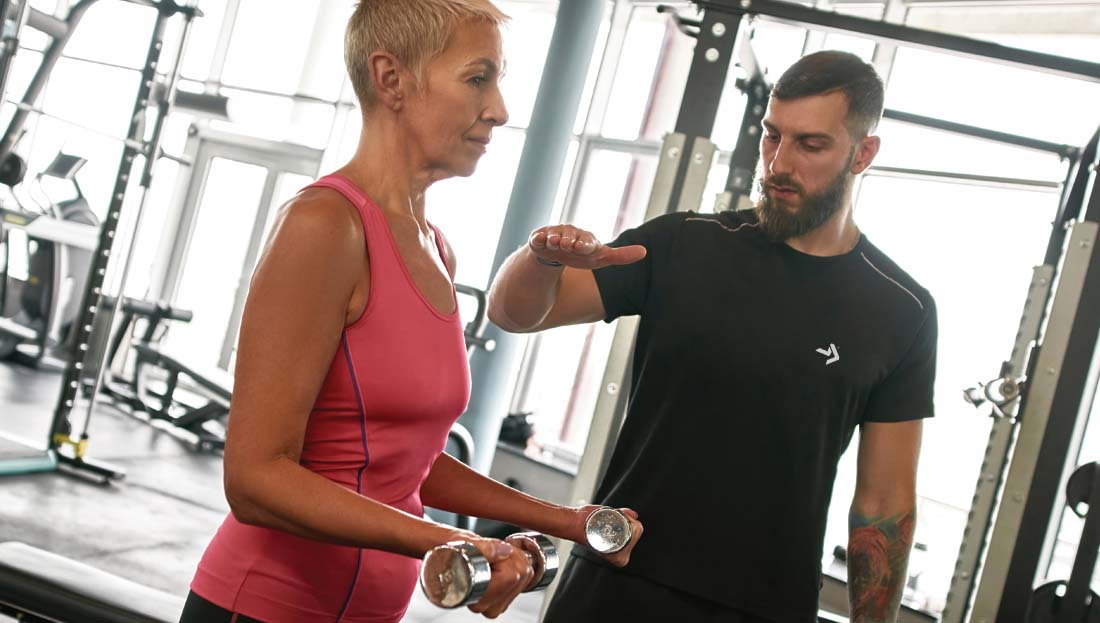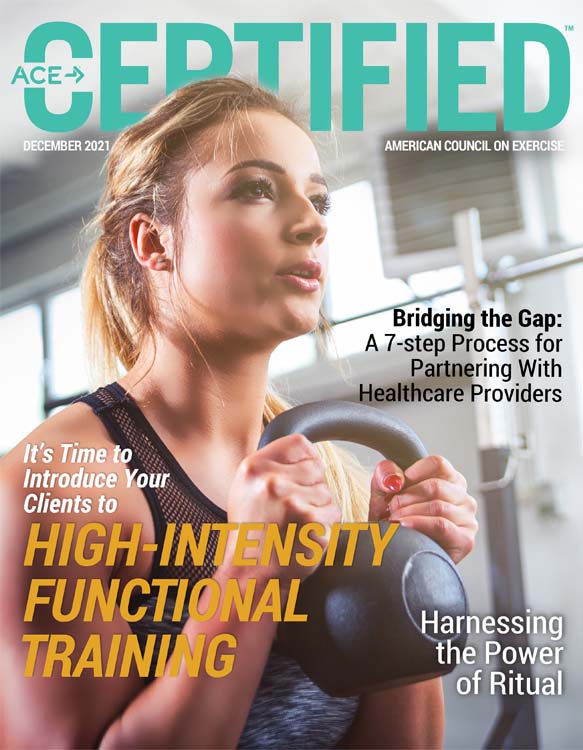
Half of women and one in five men experience fragility fractures related to poor bone mineral density (BMD) or osteoporosis. Fragility fractures can happen in men but mostly occur in post-menopausal women. While aging is associated with reduced bone density, bone health can also be impacted by diet, smoking, physical activity, alcohol intake and certain medications taken long-term. Fragility fractures can lead to decreased mobility and an increased risk of falling, and are also associated with increased mortality.
The National Institutes of Health compare bone health to a bank account. Through childhood and adolescence, bone is strengthened with more “deposits” than withdrawals, as more bone tissue grows. This continues through the twenties, when bone density may begin to deplete. Osteoporosis occurs when more “withdrawals” occur than deposits. However, bone loss can be prevented by avoiding excessive tobacco and alcohol use, eating a nutrient-dense diet and incorporating strength training.
While women 65 and older are at the greatest risk for both osteoporosis and experiencing fractures, all your clients can benefit from incorporating these healthy habits to maintain bone density throughout their lifetime.
Improving Bone Health
Evidence-based methods for improving bone health include increasing protein intake, eating more nutrient-dense foods and increasing intake of vitamin D and minerals, including calcium and magnesium. These nutrition changes in combination with muscular training—specifically weight-bearing exercise—can improve BMD and prevent fragility fractures. The literature does not suggest that any single method is sufficient on its own when attempting to increase BMD, but rather that a combined approach addressing nutrition, exercise, and supplementation, when necessary, may be most helpful.
There is less evidence than previously thought for exclusively focusing on vitamin D and calcium through dairy intake. Instead, incorporating a variety of nutrient-dense foods, including fruits, vegetables, fish and nuts, as well as increasing protein intake has been shown to be beneficial for bone health.
Nutrition habits linked to poor BMD include diets high in saturated fats, sodium and added sugars. Reducing intake of highly processed foods and incorporating more healthy fats, fiber and protein can be protective of bone health, while also positively affecting overall health and well-being as clients age.
Measuring Bone Mineral Density
BMD and fracture risk can be measured with a DXA (dual-energy x-ray absorptiometry) scan. DXA scans can also assess body composition by providing an accurate measurement of lean body mass and fat mass.
The US Preventive Services Task Force recommends women ages 65 and older, as well as post-menopausal women at increased risk for osteoporosis, have a BMD scan performed to assess their risk of osteoporosis. However, anyone can get a DXA scan to determine body composition or assess risk for osteoporosis.
When testing for BMD, the higher the score for bone mineral content, the denser and stronger the bones. The DXA scan yields two scores: a t-score and z-score. The t-score compares the result to that of a healthy 30 year old, whereas the z-score is age-adjusted. T-scores are listed as a standard deviation (for example, within 1 standard deviation of a healthy 30 year old is a result of –1 to 1).
DXA T-score for Bone Mineral Density
|
Normal
|
–1 to 1
|
|
Low
|
–1 to –2.5
|
|
Osteoporosis
|
–2.5 or lower
|
Low BMD is referred to as osteopenia, whereas osteoporosis is characterized by very low bone density and an increased risk for bone fracture.
Coaching to Help Clients Improve Bone Health Through Lifestyle Habits
Unless you work specifically with older populations, the chances you have a client who is at high risk for bone fracture or falling may be small. However, the habits that clients adopt while working with you may help them to reduce their risk for osteoporosis as they age.
Bone Health Habit #1: Exercise
Weight-bearing progressive-overload training has been shown to be most helpful for improving BMD due to the varying load placed on the bone through pulling on the muscle. A 2019 study on exercise for the prevention of osteoporosis found the programs that are most beneficial for improving BMD in older women “have typically incorporated moderate to high-intensity loads (2–3 sets of 8–12 repetitions at 70–85% of maximal muscle strength).”
The benefits of strength training over one’s lifetime are numerous and can improve muscle, bone and joint strength. Falls are the most common cause of fractures in older populations and maintaining muscle mass and core stability during aging can help to prevent falls.
Research suggests that continuing to work out a minimum of two days per week is beneficial for bone health; however, the benefits of strength training may be reversed without consistent exercise.
Movements such as jumping jacks, squat jumps, jumping rope and step-ups can help to strengthen bones. However, clients who have been previously sedentary, particularly those who are at risk for fractures, should focus first on building core stability and balance before incorporating higher-intensity muscular training or jumping movements.
Current recommendations for populations at risk for osteoporosis include implementing a multimodal program of two or more types of exercise, which includes progressive resistance training in combination with some type of balance or mobility training or interval training. A 12-month community-based program found a multimodal program to be effective in maintaining BMD. This intervention included exercise programming three times per week and was successful at improving muscle strength, functional muscle power and balance, as well as BMD in the neck and spine.
Applied Coaching:
- Help clients set exercise goals that include muscular training and weight-bearing exercise.
- Incorporating jumping, progressive resistance training and/or balance exercise into the weekly programming is most effective for increasing BMD (when safe for the specific client’s risk and capabilities).
- For clients short on time, circuit training can be both time-efficient and beneficial for bone health.
- Open-ended questions to ask your client: How many times per week can you fit in a workout? What types of workouts do you enjoy most? What are your goals for your physical fitness? How do you envision your health as you age?
Bone Health Habit #2: Protein Intake
Protein is important for bone formation and growth and can also help to improve BMD and prevent fractures. A 2018 study on the impact of protein on bone health found evidence suggesting that a high-protein diet was beneficial for bone health as long as calcium intake is adequate. The study specifically noted that more than the current Recommended Dietary Allowance of 0.8g of protein per kg of body weight was necessary to benefit BMD.
Applied Coaching:
- Help clients set goals to meet daily protein requirements by adding protein to each meal and snack.
- Convenient high-protein foods include edamame (frozen and shelled make it even easier), rotisserie chicken, Greek yogurt and cottage cheese.
- Open-ended questions to ask your client: What type of high-protein foods do you like? How can you increase your protein intake? What specifically would make it challenging for you to eat protein at each meal? How can we problem-solve for those challenges?
Bone Health Habit #3: Vitamin D and Mineral Intake
Vitamin D, calcium and magnesium play important roles in bone health. Calcium and vitamin D work together to form part of the bone matrix and impact bone strength. Magnesium plays a role in vitamin D activation and is found in nuts, seeds and leafy green vegetables such as spinach, as well as in some fortified breads and cereals and dairy products. Dairy products are generally high in calcium; other sources include salmon, almonds and leafy green vegetables.
While most vitamin D uptake comes from sunlight exposure, a few foods are high in vitamin D, including mushrooms, oily fish like salmon and swordfish. Additionally, some dairy products are fortified with vitamin D.
Is Consuming Dairy Essential for Bone Health?
Dairy intake has mixed evidence on its ability to improve bone mass and prevent fractures. A 2018 meta-analysis focused on dairy intake in relation to risk for hip fracture suggested that yogurt and cheese intake reduced the risk of hip fracture, whereas total dairy intake did not appear to have the same positive effect. Another research review published the same year concluded that there was strong evidence supporting the link between dairy intake and a reduced risk of fracture among Caucasian and Chinese women, but the evidence is inconclusive in other populations. However, a 2020 meta-analysis found that “greater intake of milk and dairy products was not associated with a lower risk of osteoporosis and hip fracture.”
Currently, there is no consensus on this issue. However, while dairy alone has not been shown to reduce one’s risk of developing osteoporosis, it can be helpful when included as part of a balanced diet that includes fruits, vegetables, whole grains, nuts, seeds, fish, legumes, soy products and lean meats.
If a client prefers to avoid dairy or if they have a dairy allergy, it is possible to meet calcium requirements from other foods such as green leafy vegetables, legumes, fortified foods, soy, chia seeds, oranges and almonds. Clients who eat a vegan diet may need to use supplementation to obtain sufficient calcium intake.
If clients are severely deficient in vitamin D, their healthcare provider may temporarily prescribe a high dose of vitamin D or suggest using over-the-counter supplementation. The client should consult their primary care provider for suggested vitamin D dosing. While health coaches and exercise professionals can work together with clients to identify sources of specific minerals and set goals around intake, it is outside the scope of practice of a health and exercise professional to recommend supplements and to tell clients what to eat and what not to eat. For example, instead of telling a client who is looking to increase their calcium intake to eat more dairy foods and salmon, you could instead tell them that dairy foods and salmon are good sources of calcium and then let the client decide if they would like to set a goal around increasing their intake of such foods.
While no single food will prevent bone loss or fractures, eating a wide variety of nutrient-dense foods can be beneficial in maintaining bone mass.
Applied Coaching:
- Using a 24-hour food recall or a food journal can help clarify a client’s current dietary intake and identify areas for improvement. Look over the food journal with the client and ask for their opinion on where they could improve. Follow the client’s lead on nutrition goal setting.
- If a client struggles with eating fruits or vegetables, using prepared or pre-cut fruit or veggies can save time, and portable fruits and veggies, such as apples, bananas, oranges, carrot sticks and sugar snap peas, are easy to take on the go.
- Supplementation may be beneficial if the client does not eat a wide variety of fruits and vegetables and other nutrient-dense foods such as nuts, seeds and fish. The client’s healthcare provider can interpret lab results to determine if the client is deficient in any nutrients.
- Open-ended questions to ask your client: Which of these foods are you open to incorporating (fruits, vegetables, nuts, seeds, fish, legumes) into your diet? What fruits and vegetables do you like most? Which would you like to focus on first? How many servings would you like to set a goal to eat? What would make it easier to incorporate these foods into your diet?
Increasing BMD is crucial in improving health and longevity, as well as the quality of life as we age. As a health and exercise professional, you can play an important role in helping clients experience increased health and well-being by focusing on habits that support bone health.





 by
by 


